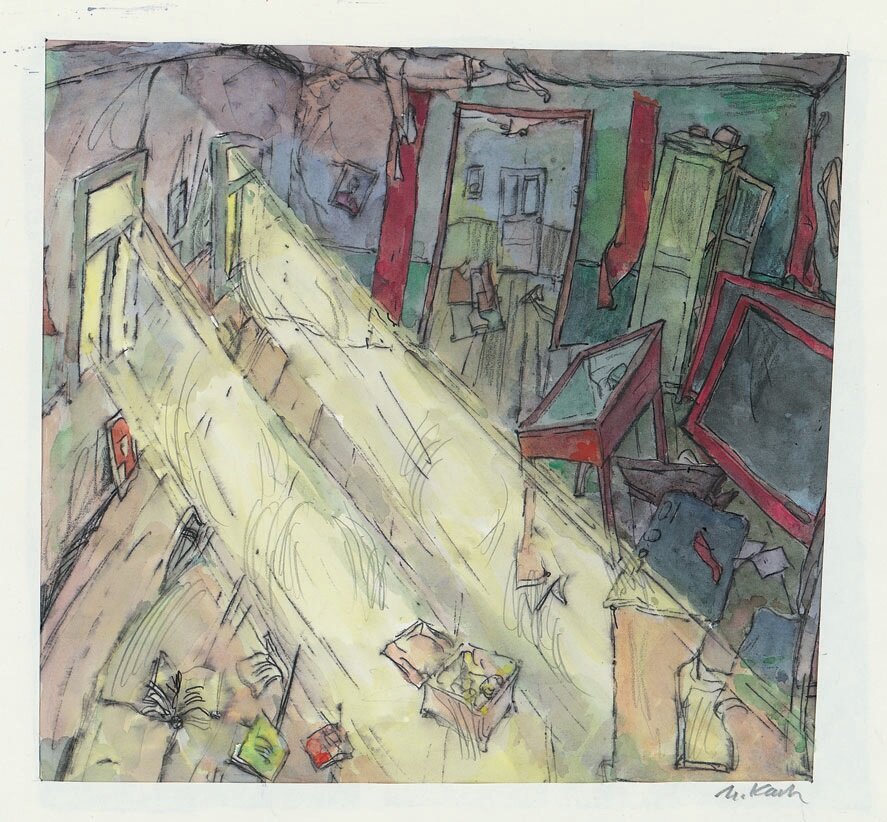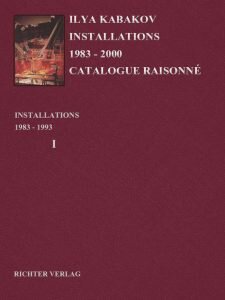The Deserted School or School #6
YEAR: 1993
CATALOGUE NUMBER: 75
PROVENANCE
The artist
Collection The Chinati Foundation, Marfa
EXHIBITIONS
Marfa
Permanent installation, 9 Oct 1993
DESCRIPTION
The viewer enters through open empty doors of a school and winds up in an entryway, where old slogans are hanging along with announcements and honor boards. If you turn to the left, the remains of the cafeteria and of the old school kitchen are visible, with little tables where kids used to have lunch. Behind the cafeteria opens up a long suite of former classrooms. At some point, they were divided by walls (the entrance into each classroom was from a gallery that went along the perimeter of the entire courtyard). Now there are no more walls. In their place, you can see beams on the floor, and altogether a long empty corridor with apertures of empty windows along both sides is formed. But on the walls of the former classrooms, one can see lesson schedules, programs of lessons in each class. On the floor, there are discarded notebooks that no one needs, textbooks, pens … In addition to these, there are also other, larger ‘school objects’: old maps, slate boards with notes on them, stand-boards with announcements, drawings, caricatures, mathematical problems …
If you turn back the other way into the entryway, then to the right (symmetrically to the cafeteria) there are the remains of the ‘teachers’ room’ – cabinets with supplies, school archives. On the floor and on old dust-covered tables there are school journals, field-trip schedules, progress reports, teachers’ shifts, etc. Beyond the ‘teachers’ room’ is the former zoological and geographical room: maps, models of mountains and oceans, stuffed birds and animals, tables of insects, fish, animals.
The next room, apparently, is the former classroom for art lessons (we can judge what was in each room only by the things that are left on the floor and walls, since just like in the left wing, there are no walls remaining to separate the rooms from one another: they have been destroyed, and empty space, like in the other half of the school, is visible to the very end). In this ‘classroom’ there are music stands, easels, drawing boards, theatrical costumes, masks on walls among the remaining children’s drawings and sketches for decorations.
Beyond this room is the sports game room. There is a climbing wall, balls on the floor, barbells, a volleyball net, and other sports inventory.
Farther, there is a room where children’s collections are exhibited. Standing along the perimeter of it are things that for some unknown reason were preserved: showcases where under glass in wonderful, undisturbed condition there is a collection of small objects, and under each is a short history, written by the pupil himself, of what each object is connected with for him and why he decided to make a collection out of them. There are 12 such collections.
Beyond this room is the room for ‘ideological education.’ Remains of posters are hanging, all kinds of appeals ‘for study, for discipline, for great progress,’ etc.
The last room is the room of military education. There are posters with depictions of the ‘class enemy’ – the bourgeois and his enemy army, the rules of military and drill readiness, etc. From all the rooms you can exit through separate doors into the courtyard of the school. Now it is completely overgrown with grass, and you can walk around it only along the inside gallery. In one of the corners of the gallery, the one closest to the entryway remains of the school toilet are visible, made out of boards with two entrances for boys and girls. The entire space of the school is flooded with sunshine and quiet. Sunny squares lie on the school floor. The blue sky is visible in the empty apertures. From all of this, the neglect reigning around does not seem so cheerless and depressing.
Perhaps there was in the past of each person who enters here, a school with a similar layout of classrooms and attributes, and, who knows, perhaps it is preserved in his memory I just like the image he sees here of School No. 6.
CONCEPT OF THE INSTALLATION
For many years the village school was in this place. The village where it was situated was small, and therefore there weren’t many children who went to it, and they received only an elementary education: there were six grades in the school. But among other village schools, No. 6 was considered to be very well equipped. There was a good staff of teachers, and the director was concerned with all that was necessary for the children who spent almost the entire day at the school: there was a gym class, a class for studying art and singing, a buffet cafeteria … Life in it went along happily. Everything in the school was in complete order, and among other schools of the region it was in first place in terms of ‘progress’ and in terms of the ‘organization of the academic process.’
If only something had not started to occur beyond the walls of the old school. The working village where it was located and which was the home of the children who ran there with such pleasure every morning, gradually started to decay and die. Perhaps there was no point in working in it any longer: the factory around which the village had been built decayed, grew old. Or perhaps life itself, isolated from other places, was becoming excessive and hard, or perhaps there were other reasons. But gradually, first one, then another family picked themselves up and moved away, and along with them the children, and it soon became clear that there was no sense in having and maintaining a school in this place.
The school was closed. No one had any need for the school building or for the other buildings of the village, and today there is emptiness and oblivion where just yesterday there was life and voices resounded. It is empty in the rooms. The courtyard is overgrown with grass up to one’s waist, and there is only wind, freely blowing through the building, through the empty windows, rustling the children’s notebooks left on the floor and the announcements about lessons and old geographical maps on the peeling walls . . .
Images
Literature









